YOJANA September 2024
Chapter 1- Highlights of the Union Budget 2024-25
Budget Estimates 2024-25:
- Total receipts other than borrowings: `32.07 lakh crore.
- Total expenditure: `48.21 lakh crore.
- Net tax receipt: `25.83 lakh crore.
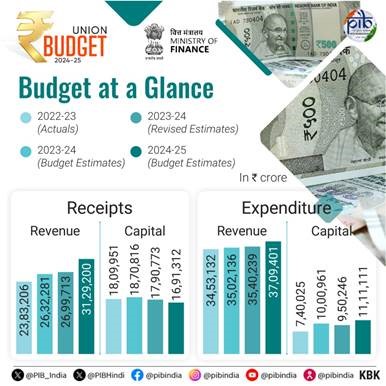
- Fiscal deficit: 4.9 per cent of GDP.
- Government aims to reach a deficit below 4.5 per cent next year.
- Inflation continues to be low, stable and moving towards the 4% target; Core inflation (non-food, non-fuel) at 3.1%.
- The focus of budget is on EMPLOYMENT, SKILLING, MSMEs, and the MIDDLE CLASS.
Package of PM’s five schemes for Employment and Skilling
- Prime Minister’s Package of 5 Schemes and Initiatives for employment, skilling and other opportunities for 4.1 crore youth over a 5-year period.
1. Scheme A - First Timers: One-month salary of up to `15,000 to be provided in 3 installments to firsttime employees, as registered in the EPFO.
2. Scheme B - Job Creation in manufacturing: Incentive to be provided at specified scale directly, both employee and employer, with respect to their EPFO contribution in the first 4 years of employment.
3. Scheme C - Support to employers: Government to reimburse up to `3,000 per month for 2 years towards EPFO contribution of employers, for each additional employee.
4. New centrally sponsored scheme for Skilling
- 20 lakh youth to be skilled over a 5-year period.
- 1,000 Industrial Training Institutes to be upgraded in hub and spoke arrangements.
5. New Scheme for Internship in 500 Top Companies to 1 crore youth in 5 years
Indirect Taxes GST
GST
- Buoyed by GST’s success, tax structure to be simplified and rationalised to expand GST to remaining sectors.
Sector specific customs duty proposals Medicines and Medical Equipment
Medicines and Medical Equipment
- Three cancer drugs namely Trastuzumab Deruxtecan, Osimertinib and Durvalumab fully exempted from custom duty.
- Changes in Basic Customs Duty (BCD) on x-ray tubes & flat panel detectors for use in medical x-ray machines under the Phased Manufacturing Programme.
Mobile Phone and Related Parts
- BCD on mobile phone, mobile Printed Circuit Board Assembly (PCBA) and mobile charger reduced to 15 per cent.
Precious Metals
- Customs duties on gold and silver reduced to 6 per cent and that on platinum to 6.4 per cent.
Other Metals
- BCD removed on ferro nickel and blister copper.
- BCD removed on ferrous scrap and nickel cathode.
- Concessional BCD of 2.5 per cent on copper scrap.
Electronics
- BCD removed, subject to conditions, on oxygen free copper for manufacture of resistors.
Chemicals and Petrochemicals
- BCD on ammonium nitrate increased from 7.5 to 10 per cent.
Plastics
- BCD on PVC flex banners increased from 10 to 25 per cent.
Telecommunication Equipment
- BCD increased from 10 to 15 per cent on PCBA of specified telecom equipment.
Trade facilitation
- For promotion of domestic aviation and boat & ship MRO, time period for export of goods imported for repairs extended from six months to one year.
- Time-limit for re-import of goods for repairs under warranty extended from three to five years.
Critical Minerals
- 25 critical minerals fully exempted from customs duties.
- BCD on two critical minerals reduced.
Solar Energy
- Capital goods for use in manufacture of solar cells and panels exempted from customs duty.
Marine products
- BCD on certain broodstock, polychaete worms, shrimp and fish feed reduced to 5 per cent.
- Various inputs for manufacture of shrimp and fish feed exempted from customs duty
Leather and Textile
- BCD reduced on real down filling material from duck or goose.
- BCD reduced, subject to conditions, on methylene diphenyl diisocyanate (MDI) for manufacture of spandex yarn from 7.5 to 5 per cent.
Direct Taxes
- Efforts to simplify taxes, improve tax payer services, provide tax certainty and reduce litigation to be continued.
- Enhance revenues for funding development and welfare schemes of government.
- 58 per cent of corporate tax from simplified tax regime in FY23, more than two-thirds taxpayers availed simplified tax regime for personal income tax in FY 24.
Simplification for Charities and of TDS
- Two tax exemption regimes for charities to be merged into one.
- 5 per cent TDS rate on many payments merged into 2 per cent TDS rate.
- 20 per cent TDS rate on repurchase of units by mutual funds or UTI withdrawn.
- TDS rate on e-commerce operators reduced from one to 0.1 per cent.
- Delay for payment of TDS up to due date of filing statement decriminalized.
Simplification of Reassessment
- Assessment can be reopened beyond three years upto five years from the end of Assessment Year only if the escaped income is Rs 50 lakh or more.
- In search cases, time limit reduced from ten to six years before the year of search.
Simplification and Rationalisation of Capital Gains
- Short term gains on certain financial assets to attract a tax rate of 20 per cent.
- Long term gains on all financial and non-financial assets to attract a tax rate of 12.5 per cent.
- Exemption limit of capital gains on certain financial assets increased to Rs 1.25 lakh per year.
Tax Payer Services
- All remaining services of Customs and Income Tax including rectification and order giving effect to appellate orders to be digitalized over the next two years.
Litigation and Appeals
- ‘Vivad Se Vishwas Scheme, 2024’ for resolution of income tax disputes pending in appeal.
- Monetary limits for filing direct taxes, excise and service tax related appeals in Tax Tribunals, High Courts and Supreme Court increased to Rs 60 lakh, Rs 2 crore and Rs 5 crore respectively.
- Safe harbour rules expanded to reduce litigation and provide certainty in international taxation.
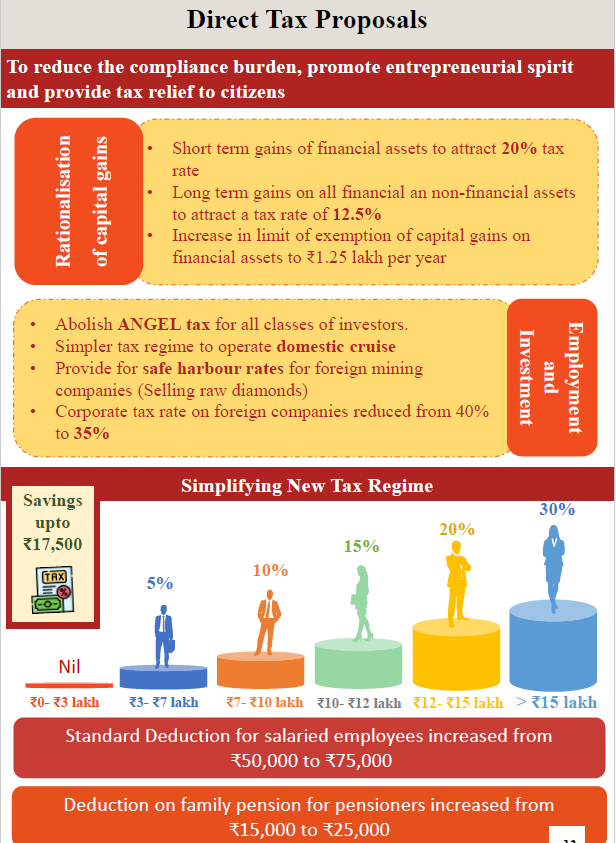
Employment and Investment
- Angel tax for all classes of investors abolished to bolster start-up eco-system,.
- Simpler tax regime for foreign shipping companies operating domestic cruises to promote cruise tourism in India.
- Safe harbour rates for foreign mining companies selling raw diamonds in the country.
- Corporate tax rate on foreign companies reduced from 40 to 35 per cent.
Deepening tax base
- Security Transactions Tax on futures and options of securities increased to 0.02 per cent and 0.1 per cent respectively.
- Income received on buy back of shares in the hands of recipient to be taxed.
Social Security Benefits.
- Deduction of expenditure by employers towards NPS to be increased from 10 to 14 per cent of the employee’s salary.
- Non-reporting of small movable foreign assets up to Rs 20 lakh de-penalised.
Other major proposal in Finance Bill
- Equalization levy of 2 per cent withdrawn.
Changes in Personal Income Tax under new tax regime
- Standard deduction for salaried employees increased from Rs 50,000 to Rs 75,000.
- Deduction on family pension for pensioners enhanced from Rs 15,000/- to Rs 25,000/-
- Revised tax rate structure:
Chapter 2- Public Finance and Development
The Union Budget 2024-25 was recently presented in the Parliament, marking the first general budget of the 18th Lok Sabha.
- The budget’s primary focus is on four key groups: the ‘Poor’, ‘Women’, ‘Youth’, and ‘Farmers’.
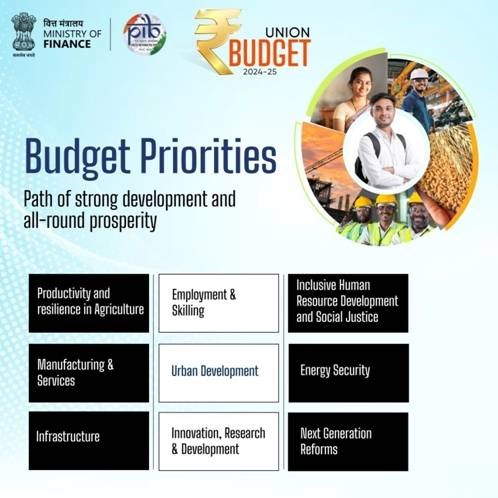
- The Union Budget 2024-25 focuses on employment, skill development, support for MSMEs, and the middle class, with a notable allocation of Rs 1.48 lakh crore dedicated to education, employment, and skilling initiatives.
- The budget focuses on 9 key priorities:
- Productivity and resilience in Agriculture
- Employment & Skilling
- Inclusive Human Resource Development and Social Justice
- Manufacturing & Services
- Urban Development
- Energy Security
- Infrastructure
- Innovation, Research & Development and
- Next Generation Reforms
Priority 1: Productivity and Resilience in Agriculture:
- The budget emphasizes the transformation of India’s agricultural sector, recognizing its crucial role in supporting 42.3% of the population and contributing 18.2% to the GDP.
- With a focus on ensuring food security, improving farmers’ income, and making agriculture more productive, sustainable, and resilient to climate change, the sector has been allocated Rs 1.52 lakh crore.
- Key initiatives in Agriculture:
- Agricultural Research Transformation: A comprehensive revamp of agricultural research to boost productivity and develop climate-resilient crop varieties. This includes the introduction of 109 new high-yielding, climate-resilient varieties and funding in a challenge mode for public and private research.
- Promotion of Natural Farming: The government plans to support one crore farmers in adopting natural farming practices, setting up 10,000 bio-input resource centers, and aiding certification and branding.
- Self-Sufficiency in Pulses and Oilseeds: Focus on achieving self-sufficiency in pulses and oilseeds to reduce imports by strengthening their production, storage, and marketing.
- Vegetable Production and Supply Chains: Plans to develop large-scale clusters for vegetable production near consumption centers, and promote Farmer Producer Organizations (FPOs), cooperatives, and startups to reduce post-harvest losses.
- Digital Public Infrastructure for Agriculture: Creation of a digital public infrastructure to provide information on crop health, inputs, credit, insurance, and market intelligence. This includes a digital crop survey in 400 districts and the inclusion of 6 crore farmers in registries.
- Additionally, the government plans to boost shrimp production and export, setting up breeding centers and providing financing for shrimp farming. The National Cooperation Policy will also support the development of the cooperative sector, aiming for rural growth and job creation.
Priority 2: Employment & Skilling:
- The Union Budget 2024-25 emphasizes employment generation and skilling to harness India’s demographic dividend.
- A Rs 2 lakh crore Prime Minister’s Package aims to benefit 4.1 crore youth over five years through 5 key schemes:
- Employment Linked Incentive Scheme-A: Targets 2.1 crore new workforce entrants with salaries up to Rs 1 lakh per month. The government will pay up to Rs 15,000 in instalments to employees, with employers refunding the subsidy if employment ends within 12 months.
- Employment Linked Incentive Scheme-B: Focuses on job creation in manufacturing, benefiting 30 lakh youth. Employers hiring at least 25% more EPFO employees will receive wage subsidies, with government contributions phased over four years.
- Employment Linked Incentive Scheme-C: Supports employers to incentivize hiring 50 lakh people across all sectors. Employers increasing EPFO employees receive up to Rs 3,000 per month per additional hire for two years.
- Skilling Initiatives: A new Centrally Sponsored Scheme with Rs 60,000 crore will skill 20 lakh youth by upgrading 1,000 Industrial Training Institutes (ITIs) in collaboration with industry. Additionally, the Prime Minister’s Internship Scheme will skill one crore youth via internships at top companies, with government funding part of the stipend.
- Support for Women: The government will build working women hostels and creches, offer skilling loans, and provide education loans of up to Rs 10 lakh for 1 lakh students with a 3% interest subsidy.
Priority 3: Inclusive Human Resource Development and Social Justice:
- The Union Budget 2024-25 emphasizes inclusive human resource development and social justice, targeting comprehensive growth for all sections of society. Key initiatives include:
- Saturation Approach for Social Justice: Ensuring that all eligible individuals are covered in programs for education, health, and economic activities, benefiting craftsmen, artisans, selfhelp groups, marginalized communities, and women entrepreneurs.
- Purvodaya Initiative: Focuses on transforming the eastern region of India by developing human resources, infrastructure, and opportunities to drive economic growth and make the region a powerhouse for a developed India.
- Women-Led Development: Allocates over Rs 3 lakh crore for women’s and girls’ schemes, enhancing their health, nutrition, and education while recognizing their role in economic development.
- Pradhan Mantri Janjatiya Unnat Gram Abhiyan: A new initiative to improve the socio-economic conditions of tribal communities, benefiting over 5 crore people in 63,000 villages in tribalmajority and aspirational districts.
- India Post Payment Bank Expansion: Over 100 new branches will open in the North East to expand banking services and boost economic growth.
- Increased Funding for Education, Healthcare, and Housing: Education funding increased by 12% to Rs 1.2 lakh crore, healthcare by 15% to Rs 3.8 lakh crore, and the PM Awas Yojana will support the construction of 3 crore additional houses.
Priority 4: Manufacturing & Services:
- MSME Support: Rs 1.5 lakh crore is allocated to MSMEs, with measures to improve credit access, reduce compliance burdens, and offer technical support.
- This includes a Credit Guarantee Scheme for term loans, a new Credit Assessment Model using digital footprints, and Credit Support for MSMEs during stress periods to prevent NPAs.
- The turnover threshold for mandatory onboarding on the TReDS platform is reduced to Rs 250 crore to unlock working capital.
- Manufacturing Boost: The government will develop industrial parks in 100 cities and offer rental housing for industrial workers through PPP models.
- The Production Linked Incentive (PLI) Scheme will receive Rs 2 lakh crore to boost domestic manufacturing and attract investment in key industries like electronics, textiles, and automobiles.
- Service Sector and Digital Infrastructure: Expansion of Digital Public Infrastructure (DPI) will enhance productivity in areas like credit, e-commerce, and urban governance.
- The budget also supports startups by abolishing the “Angel Tax” for all classes of investors, encouraging investment and innovation.
Priority 5: Urban Development:
- Cities as Growth Hubs: Collaboration between the union and state governments will develop cities into growth hubs through economic and transit planning, and orderly peri-urban development using town planning schemes.
- Creative Redevelopment: A framework for policies, market mechanisms, and regulations will enable the redevelopment of existing cities, transforming urban spaces.
- Transit-Oriented Development: Plans will be formulated for 14 large cities (population over 30 lakh) to promote development around transit systems.
- Urban Housing: Rs 10 lakh crore will be invested to build 1 crore houses for the urban poor and middle-class families over five years, with interest subsidies for affordable loans and a transparent rental housing market.
- Water Supply and Sanitation: In partnership with state governments and multilateral banks, projects for water supply, sewage treatment, and waste management will be implemented in 100 cities.
Priority 6: Energy Security:
- Energy Transition Policy: A new policy will balance employment, growth, and environmental sustainability, with Rs 1.5 lakh crore allocated for renewable energy projects, including solar, wind, and green hydrogen.
- Surya Char Mutt Bijli Yojana: This scheme aims to provide free electricity (up to 300 units/month) through rooftop solar plants for 1 crore households, with Rs 6,250 crore allocated.
- Pumped Storage Policy: A new policy will promote pumped storage projects for electricity, facilitating renewable energy integration.
- R&D in Nuclear Energy: The government will fund research and development for small and modular nuclear reactors in collaboration with the private sector.
- Water Supply and Sanitation: In partnership with state governments and multilateral banks, projects for water supply, sewage treatment, and waste management will be implemented in 100 cities.
- Advanced Ultra Super Critical Thermal Power: Fiscal support will help set up an 800 MW commercial plant using advanced thermal power technology.
Priority 7: Infrastructure:
- Government Infrastructure Investment: Rs 11.1 lakh crore, or 3.4% of GDP, has been allocated for capital expenditure, with Rs 1.5 lakh crore earmarked for states under the Special Assistance for Capital Investment scheme.
- Private Infrastructure Investment: The government will promote private sector involvement through viability gap funding and market-based financing.
- Pradhan Mantri Gram Sadak Yojana (PMGSY) Phase IV: This phase will provide all-weather connectivity to 25,000 additional rural habitations.
- Tourism Infrastructure: The government will assist states in developing iconic tourist destinations to create jobs and stimulate investments.
Priority 8: Innovation, Research & Development:
- Anusandhan National Research Fund: This fund will be operationalized to support R&D efforts.
- Financing Pool: A Rs 1 lakh crore pool will be created to spur private sector-driven research and innovation on a commercial scale.
- Venture Capital Fund: Rs 1,000 crore will be allocated to expand the space economy fivefold over the next decade.
Priority 9: Next Generation Reforms:
- Economic Policy Framework: The government will define a framework to guide the next wave of economic reforms, aiming to improve productivity and market efficiency.
- State Incentives: A portion of a 50-year interest-free loan will be allocated to states for implementing land-related reforms in rural and urban areas.
- FDI and Overseas Investments: Rules and regulations for Foreign Direct Investment (FDI) and overseas investments will be simplified to attract more foreign capital, prioritize investments, and encourage the use of the Indian Rupee in international transactions.
Chapter 3- Inclusive Human Resource Development and Social Justice
The Economic Survey 2023-24 and the Union Budget 2024-25 emphasize the importance of inclusive human resource development and social justice as pivotal to India’s economic growth.
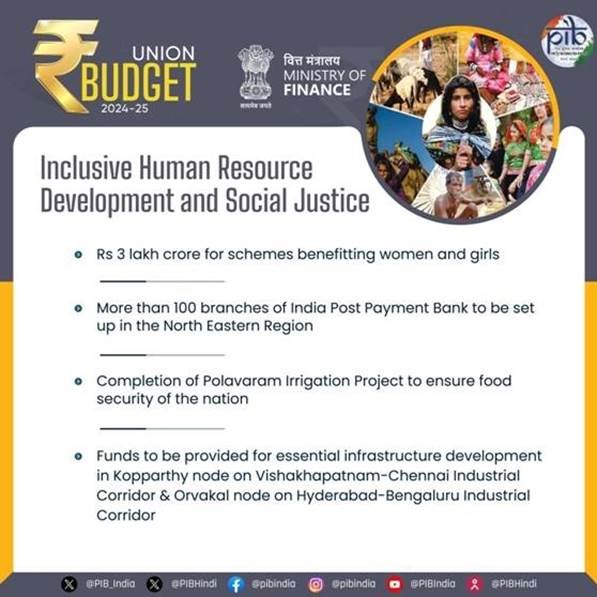
- The budget allocates significant resources to enhance education, employment, and social justice, aiming to create a more equitable and prosperous society.
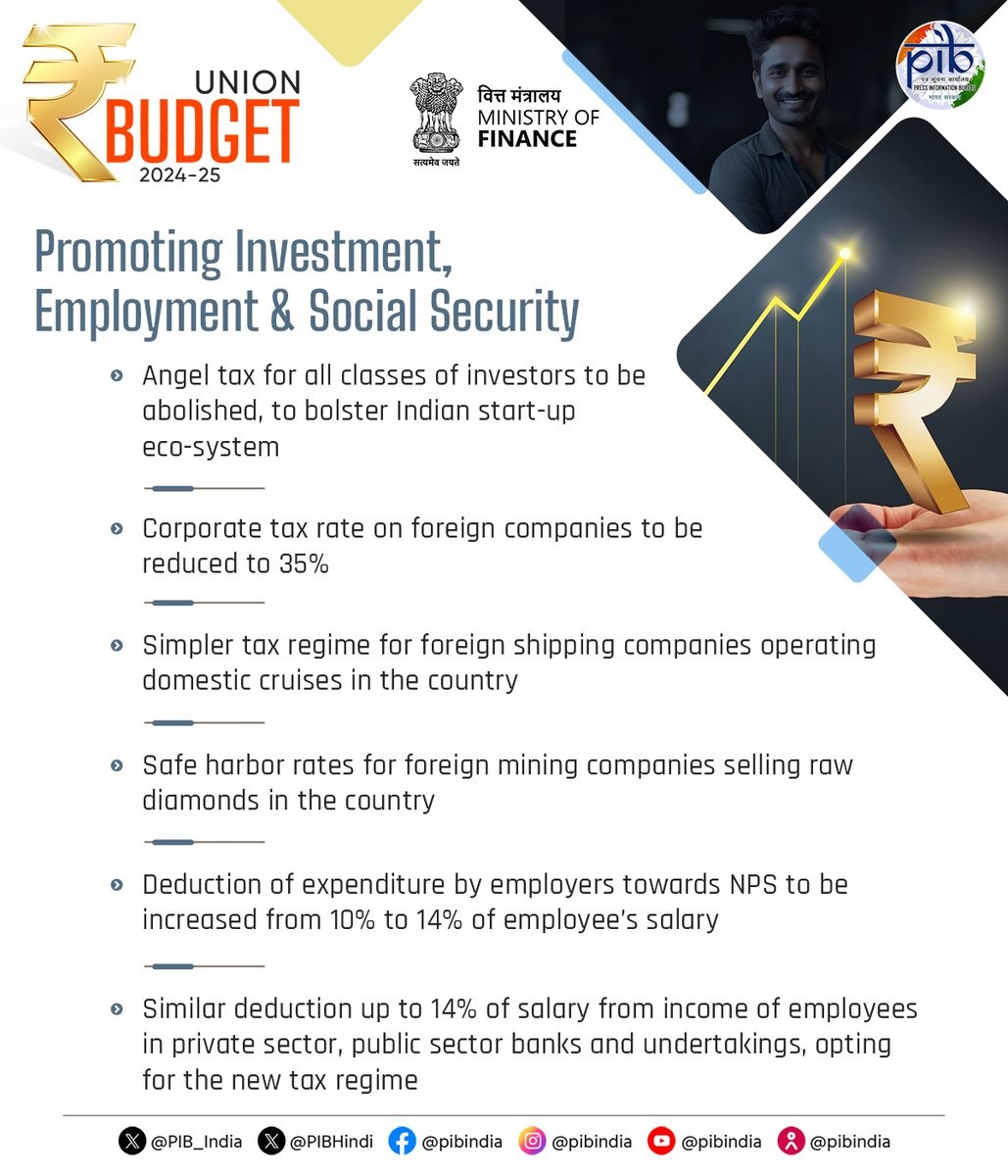
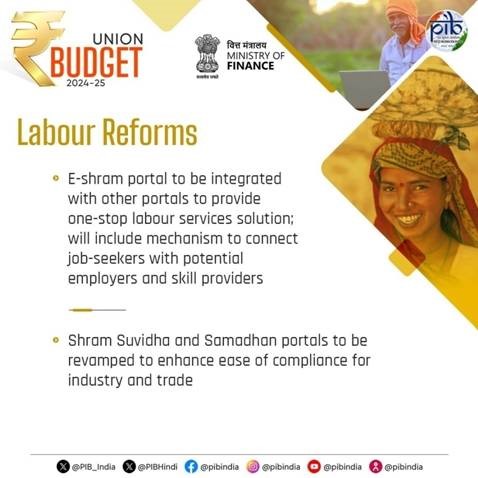
Key Initiatives:
Inclusive Human Resource Development:
- Education and Skilling: Rs 1.48 lakh crore allocated for education and skills development. Upgrading 1,000 Industrial Training Institutes (ITIs) and providing financial support for vocational training through loans and interest subsidies.
- Employment-Linked Incentives: Rs 2 lakh crore set aside for schemes targeting job creation:
- Scheme A: Wage subsidy for first-time employees.
- Scheme B: Incentives for hiring in manufacturing.
- Scheme C: Support for employers hiring new workers.
Social Justice:
- Saturation Approach: Ensures comprehensive coverage under welfare programs, like the extension of Pradhan Mantri Garib Kalyan Anna Yojana.
- Women-Led Development: Rs 3 lakh crore allocated for women-focused schemes, including support for women entrepreneurs and working women.
- Tribal Welfare: Pradhan Mantri Janjatiya Unnat Gram Abhiyan aims to improve socio-economic conditions in 63,000 villages.
Anticipated Impact:
- Economic Growth: Projects GDP growth of 7% annually, lifting millions out of poverty.
- Job Creation: Expected to significantly reduce unemployment and enhance formal employment.
- Social Equity: Focuses on ensuring that benefits of growth are shared across all segments of society.

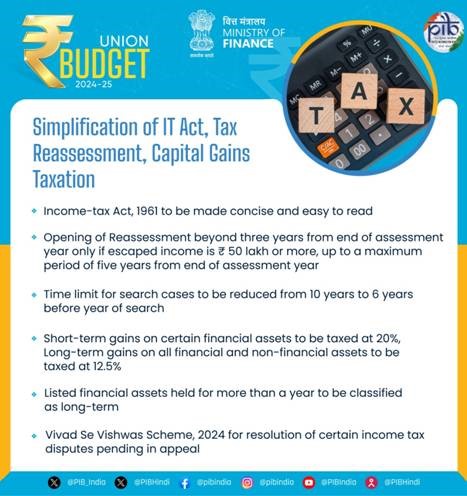
Challenges and Considerations:
- Effective governance, transparency, and robust implementation are crucial.
- Active private sector involvement is needed for skilling and job creation.
- Addressing structural issues like labor market rigidity and infrastructure gaps will support these initiatives.
Chapter 4: Energy Security
India’s Union Budget 2024-25 lays out an ambitious blueprint for the country’s energy transition, targeting the achievement of a USD 7 trillion economy and decarbonization goals by 2030.
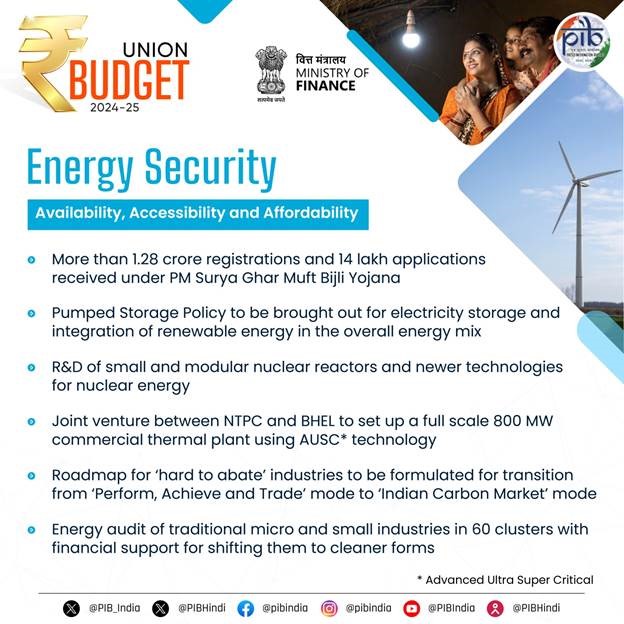
- A significant focus of this budget is on achieving 500 GW of non-fossil fuel-based energy capacity, with a target of 50% of the total installed capacity coming from renewable energy sources by 2030.
The Union Budget 2024-25 introduced several key initiatives to support India’s energy transition:
- Pumped Storage Policy: A new policy will promote pumped storage projects to facilitate energy storage and the integration of renewable energy into the grid. The growing share of renewable energy, with its intermittent nature, requires such projects for stability.
- Nuclear Energy: The government will partner with the private sector to develop Bharat Small Reactors and Small Modular Reactors, focusing on research and development of advanced nuclear technologies.
- Advanced Ultra Super Critical (AUSC) Thermal Power Plants: Indigenous technology for highly efficient AUSC thermal plants is ready, with plans to establish an 800 MW plant through a joint venture between NTPC and BHEL.
- Hard-to-Abate Industries: A roadmap will shift these industries from energy efficiency targets to emission reduction goals, with a transition towards an Indian carbon market.
- Support for Micro and Small Industries: Energy audits will be conducted for traditional industries, with financial support to shift to cleaner energy and improve energy efficiency.
- PM Surya Ghar Muft Bijli Yojana: The rooftop solar scheme for 1 crore households has seen high demand, and the government will continue to encourage it, providing up to 300 units of free electricity per month.
Renewable Energy Targets and Challenges
- To meet its renewable energy target, India needs to install 50 GW of renewable energy annually for the next five years, a sharp increase from the current annual average of 15 GW.
- Despite this aggressive target, the budget falls short in providing clear insights into how this acceleration will be achieved. The government’s focus on pumped storage and nuclear energy over wind energy and compressed biogas projects indicates a shift in priorities, but the absence of comprehensive plans for integrating these technologies into the energy mix remains a concern.
- The Pradhan Mantri Surya Ghar Muft Bijli Yojana, aimed at promoting rooftop solar installations, has seen significant public interest.
- However, the implementation is hindered by the capacity limitations of state electricity boards and outdated grid infrastructure, with only 11% of applications moving forward despite high registration numbers.
Nuclear Energy: A New Focus
- A notable shift in the energy strategy is the government’s emphasis on small modular reactors (SMRs) as part of its nuclear energy program.
- The budget outlines plans to develop Bharat Small Reactors in collaboration with the private sector to expand the role of nuclear energy in India’s energy mix.
Electric Vehicles and FAME Scheme
- The FAME Scheme, which has played a crucial role in boosting electric vehicle (EV) adoption, has seen a significant cut in allocation from Rs 5,171 crores in the previous year to Rs 2,671 crores.
- Despite this, the exemption of customs duties on critical EV battery components such as lithium and cobalt is a positive move that could encourage domestic manufacturing and reduce costs.
- However, the lack of focus on expanding public electric transport, such as electric buses, continues to hinder efforts to address vehicular pollution and congestion.
Gaps in Green Growth Initiatives
While the budget provides a framework for transitioning to renewable energy, several gaps remain. The sidelining of wind energy and biogas integration, along with limited focus on expanding electric public transport, creates a disconnect between policy aspirations and actual resource allocation. Moreover, the inconsistencies in budget allocations across various green growth initiatives cast doubt on the long-term sustainability of these schemes.
Chapter 5: Fostering Infrastructure Development
The Union Budget 2024-25 highlights infrastructure as a key priority for achieving the goal of ‘Viksit Bharat.’ The budget emphasizes long-term investment in infrastructure to drive economic growth and create opportunities across sectors.
Infrastructure Investment
- A record Rs 11.11 lakh crore has been allocated for capital expenditure, accounting for 3.4% of GDP, to boost infrastructure development.
- The central government will continue to provide fiscal support, while also encouraging states to increase infrastructure investments, backed by Rs 1.5 lakh crore in interest-free loans for states.
Public-Private Partnerships (PPP)
- Several existing mechanisms like the Public Private Partnership Appraisal Committee (PPPAC) and Viability Gap Funding (VGF) will continue to support large-scale infrastructure projects.
- From FY15 to FY24, PPP projects worth Rs 2.4 lakh crore were recommended, and VGF provided financial assistance to socially and economically viable projects.
Funding and Financing
- The budget promotes infrastructure financing through increased bank credit, external commercial borrowings (USD 9.05 billion in FY24), and market-based instruments like Infrastructure Investment Trusts (InvITs) and Real Estate Investment Trusts (REITs).
- Together, these instruments have mobilized significant resources, with InvITs raising RS 1.11 lakh crore between 2019-2024.
Pradhan Mantri Gram Sadak Yojana (PMGSY)
- Phase IV of PMGSY has been announced to provide all-weather connectivity to 25,000 rural habitations. Since 2000, over 7.65 lakh km of rural roads have been constructed, enhancing rural access.
Irrigation and Flood Mitigation
- The budget also allocates Rs 11,500 crore for irrigation projects in Bihar and announces support for flood management initiatives in states like Assam, Himachal Pradesh, Uttarakhand, and Sikkim.

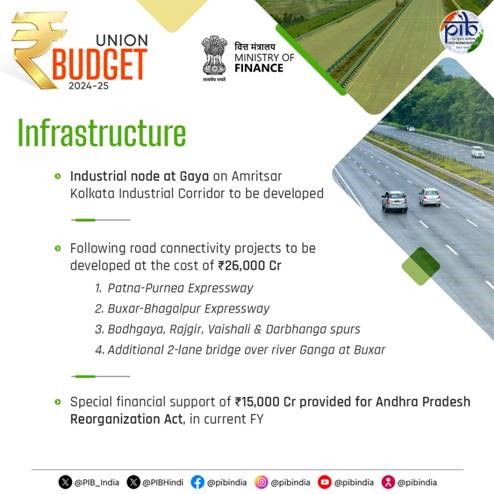
Key Urban Development Initiatives:
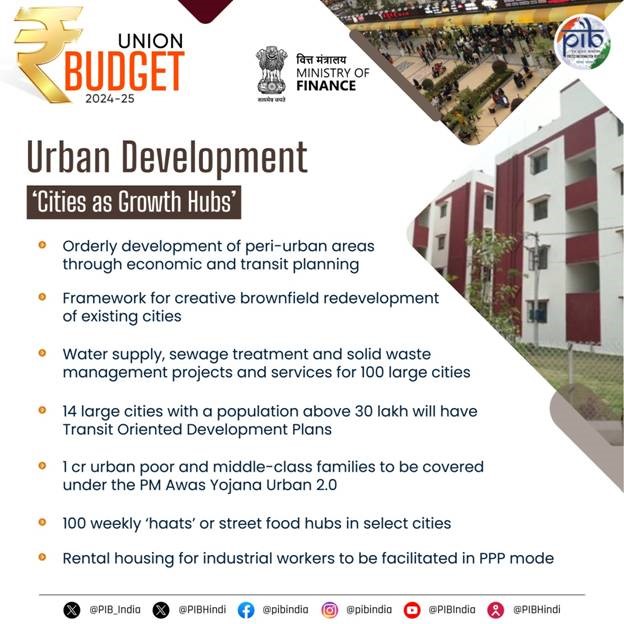
- PM Awas Yojana: The budget allocates funds for the construction of three crore additional houses under this scheme. PM Awas Yojana Urban 2.0 will address the housing needs of one crore urban poor and middle-class families with an investment of Rs 10 lakh crore, including Rs 2.2 lakh crore in central assistance over five years, along with interest subsidies for affordable loans.
- Rental Housing: Dormitory-style rental housing for industrial workers will be facilitated under a PPP model with Viability Gap Funding (VGF), and policies to improve rental housing markets will be introduced.
- Cities as Growth Hubs: The government will collaborate with states for developing cities as economic hubs, focusing on transit and peri-urban development. A framework for brownfield redevelopment will also be formulated.
- Transit-Oriented Development: Plans will be implemented in 14 cities with populations above 30 lakh, focusing on integrated transit and financing strategies.
- Water Supply and Sanitation: The government, in collaboration with states and multilateral banks, will promote bankable water, sewage, and waste management projects in 100 large cities, with provisions for using treated water for irrigation.
- Weekly ‘Haats’: A scheme to develop 100 weekly markets (haats) each year will be launched to support street vendors.
- Stamp Duty Reform: States will be encouraged to reduce high stamp duties, with further reductions for properties purchased by women. This will be tied to urban development initiatives.
Chapter 6: Focus on Manufacturing and Services
The Union Budget 2024-25 announced a comprehensive package for the promotion of MSMEs and the manufacturing sector, with special attention to labour-intensive industries. Key measures include:
Infrastructure Investment
- Credit Guarantee Scheme for MSMEs: A new scheme will be introduced to provide credit guarantees for MSMEs purchasing machinery and equipment, without the need for collateral or third-party guarantees. A self-financing guarantee fund will cover up to Rs 100 crore per applicant.
- New Assessment Model for MSME Credit: Public sector banks will develop in-house capabilities for assessing MSMEs’ creditworthiness based on their digital footprints, improving upon traditional assetbased criteria. This model will also benefit MSMEs without formal accounting systems.
- Credit Support during Stress Period: A new mechanism will ensure MSMEs continue to access bank credit during periods of financial stress, supported by a government-promoted fund. This will help MSMEs avoid slipping into non-performing asset (NPA) status.
- Enhanced MUDRA Loan: The limit for MUDRA loans will be raised to Rs 20 lakh for entrepreneurs who have successfully repaid previous loans under the ‘Tarun’ category.

- TReDS Platform Expansion: The turnover threshold for mandatory onboarding onto the Trade Receivables Discounting System (TReDS) will be reduced to ₹250 crore, helping MSMEs convert receivables into cash. This move will bring more Central Public Sector Enterprises (CPSEs) and companies onto the platform.
- New SIDBI Branches: SIDBI will establish 24 new branches in MSME clusters this year, expanding service coverage to 168 out of 242 major clusters.
- Food Irradiation and Safety Testing: Financial support will be provided for setting up 50 multi-product food irradiation units and 100 NABL-accredited food quality and safety testing labs in the MSME sector.
- E-Commerce Export Hubs: To facilitate MSMEs and traditional artisans in accessing international markets, E-commerce Export Hubs will be set up in public-private partnership (PPP) mode.
- Industrial Parks: Development of plug-and-play industrial parks in or near 100 cities in collaboration with states and private sectors. Twelve parks under the National Industrial Corridor Development Programme will also be sanctioned.
- Rental Housing: PPP-mode dormitory-type rental housing for industrial workers will be facilitated with viability gap funding (VGF).
- Shipping Industry Reforms: Ownership, leasing, and flagging reforms will be introduced to enhance India’s shipping industry and create employment.
- Critical Mineral Mission: A new mission will be established for domestic production, recycling, and overseas acquisition of critical minerals, along with technology development and financing mechanisms.
- Offshore Mineral Mining: The first tranche of offshore mineral blocks will be auctioned for mining, leveraging existing exploration data.
- Digital Public Infrastructure: Digital applications will be developed at scale to drive productivity and innovation in sectors like credit, e-commerce, education, health, logistics, and urban governance.
- Insolvency and Bankruptcy Code (IBC) Reforms: An integrated technology platform will be set up to streamline IBC processes, improving transparency and outcomes. Additional National Company Law Tribunals (NCLTs) will be established to handle cases more efficiently.
- Debt Recovery Tribunals: Reforms will be introduced to strengthen debt recovery mechanisms, including the establishment of additional tribunals to expedite recovery processes.
Mains Practice Question: - (in around 250 words)
Q1. The Union Budget 2024-25 focuses on the promotion of MSMEs and labor-intensive manufacturing sectors. Critically evaluate the measures announced in the budget to support the growth and competitiveness of MSMEs in India.
Q2. Discuss the significance of the Union Budget 2024-25’s focus on infrastructure development, particularly through industrial parks and transit-oriented development plans. How will these initiatives impact India’s urban growth and manufacturing sector?